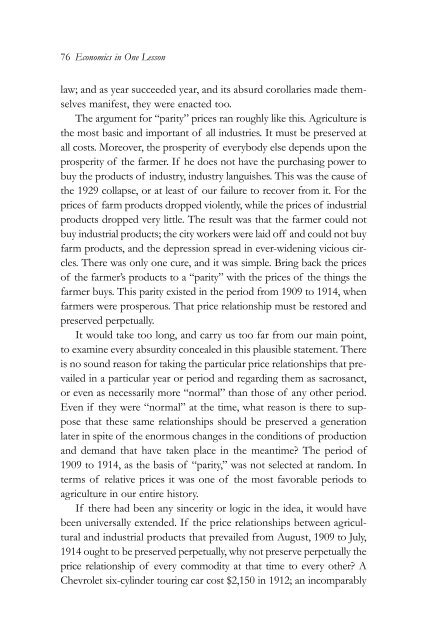1gDdM7w
1gDdM7w
1gDdM7w
- No tags were found...
You also want an ePaper? Increase the reach of your titles
YUMPU automatically turns print PDFs into web optimized ePapers that Google loves.
76 Economics in One Lessonlaw; and as year succeeded year, and its absurd corollaries made themselvesmanifest, they were enacted too.The argument for “parity” prices ran roughly like this. Agriculture isthe most basic and important of all industries. It must be preserved atall costs. Moreover, the prosperity of everybody else depends upon theprosperity of the farmer. If he does not have the purchasing power tobuy the products of industry, industry languishes. This was the cause ofthe 1929 collapse, or at least of our failure to recover from it. For theprices of farm products dropped violently, while the prices of industrialproducts dropped very little. The result was that the farmer could notbuy industrial products; the city workers were laid off and could not buyfarm products, and the depression spread in ever-widening vicious circles.There was only one cure, and it was simple. Bring back the pricesof the farmer’s products to a “parity” with the prices of the things thefarmer buys. This parity existed in the period from 1909 to 1914, whenfarmers were prosperous. That price relationship must be restored andpreserved perpetually.It would take too long, and carry us too far from our main point,to examine every absurdity concealed in this plausible statement. Thereis no sound reason for taking the particular price relationships that prevailedin a particular year or period and regarding them as sacrosanct,or even as necessarily more “normal” than those of any other period.Even if they were “normal” at the time, what reason is there to supposethat these same relationships should be preserved a generationlater in spite of the enormous changes in the conditions of productionand demand that have taken place in the meantime? The period of1909 to 1914, as the basis of “parity,” was not selected at random. Interms of relative prices it was one of the most favorable periods toagriculture in our entire history.If there had been any sincerity or logic in the idea, it would havebeen universally extended. If the price relationships between agriculturaland industrial products that prevailed from August, 1909 to July,1914 ought to be preserved perpetually, why not preserve perpetually theprice relationship of every commodity at that time to every other? AChevrolet six-cylinder touring car cost $2,150 in 1912; an incomparably


